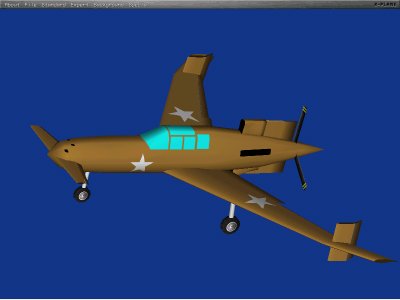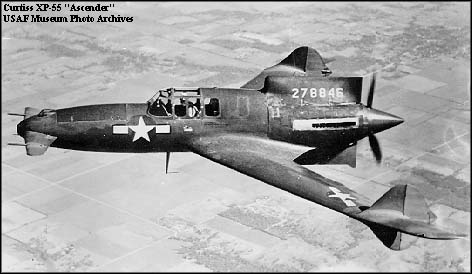 Curtiss XP-55 Ascender
Curtiss XP-55 Ascender Curtiss XP-55 Ascender
Curtiss XP-55 AscenderFrom the Smithsonian National Air and Space Museum XP-55 Page
The XP-55 grew out of the Air Corp's Request for Data R-40C, a document released late in 1939. R-40C sought to 'jump-start' designers into departing from accepted, low-risk, aircraft design practices, and encourage them to embrace radical new technology. Along with the new concepts came the increased risk of program failure for airplanes that were simply too far beyond the cutting-edge.
On June 22, 1940, Curtiss received a contract for engineering data and a powered, wind tunnel model along with an option for a prototype. By November 2, Curtiss had completed a 1/4 scale powered model and designed two different sweptback wings, one with a conventional airfoil and the other with a new, low-drag, laminar flow airfoil. To control yaw, Curtiss mounted a small vertical fin and rudder on each wingtip. Exhaustive wind-tunnel tests that ran from November 1940 through January 1941 left the Air Corps unimpressed but still interested enough in the design to order further study of the laminar flow wing.
The Curtiss factory in St. Louis, Missouri, completed the first prototype XP-55 in July 1943 and quickly moved to the flight test phase. The test schedule was progressing satisfactorily until November 15. During a stall test, the aircraft suddenly pitched forward in an outside loop until it stopped inverted, falling straight down. The engine had failed for lack of fuel so righting the stricken fighter with engine power alone was impossible. The Ascender and its helpless pilot fell 4,900 m (16,000 ft) before the pilot bailed out. The airplane dug a smoking hole in the ground. More wind tunnel tests followed and the results led to corrections that Curtiss included in the third prototype. The second prototype was already too far along in construction to incorporate any improvements.
The second Ascender flew for the first time on January 9, 1944, but not without major restrictions on in-flight maneuvering. The third prototype flew late in April. After much testing, it looked as though the deadly stall situation that doomed the first XP-55 was cured. Curtiss retrofitted the stall fixes into prototype number 2, and resumed testing it in September 1944. The Army Air Forces (AAF) carried out some armament testing with Ascender number 3 but the end was near for the whole project. Pilots feared the Ascender's vicious stall characteristics and it was just plain slow compared to most fighters already in production. The program ended after the third prototype crashed at Wright Field during an air show.
The version I modeled is the third prototype which has the extended wingtips with "trailerons" as Curtiss called them. The already high aspect wing becomes even more tapered which makes for poor stalling characteristics. I worked off a three view drawing in one of my books and the dimensions are pretty accurate, although I had to reduce the propeller blade length from five to four and a half feet to limit ground strikes on rotation.
Finally I was not able to duplicate one interesting facet of the XP-55 design. When the flaps were lowered, the ailerons were trimmed upwards to increase rotational moment. In X-Plane the ailerons can be tied to the flaps, but will only droop downwards.
As you start rolling, watch out for the snaking motion and catch it with rudder. As soon as you are airborne and establish a positive climb rate, get the flaps and gear up. DON'T try any fancy maneuvering until you have some serious airspeed! When your speed is over a couple of hundred mph you can try some turns. With sufficient airspeed the Ascender will turn at better than five G's, but speed bleeds off fast. If you use autopilot for heading and altitude it's possible to get close to 400mph.
I'll leave it up to you to discover the joys of landing the Ascender!
Download the Curtiss XP-55 Ascender version 1.0 (X-Plane version 5.62)


| Email James Z Temple | Return to Home Page |